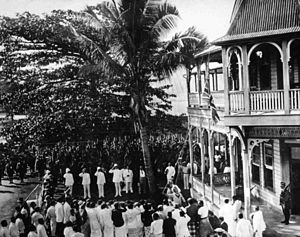- Occupation of German Samoa
-
Occupation of German Samoa Part of the Asian and Pacific theatre of World War I 
Union Flag at Government Building, Apia, 30 August 1914Date 1914 Location German Samoa Result Allied victory Belligerents  United Kingdom
United Kingdom
 GermanyTheatres of World War I
GermanyTheatres of World War I- Caucasus
- Persia
- Gallipoli
- Mesopotamia
- Sinai and Palestine
- South Arabia
- South-West Africa
- West Africa
- East Africa
- North Africa
Other theatres:
- America
- Atlantic Ocean
- Mediterranean
The Occupation of Samoa was the takeover and subsequent administration of the Pacific colony of German Samoa in August 1914 by an expeditionary force from New Zealand called the Samoa Expeditionary Force and New Zealand's first action in World War I. On 7 August 1914, the British government indicated that it would be a great and urgent Imperial service if New Zealand forces seized the wireless station near Apia,[1] one of several German radio stations used by the German East Asia Squadron. Since the days of Seddon, New Zealand had aspired to control Samoa, and in 1913 General Godley had discussed the seizure of German Samoa with British military authorities.
A 1,370-man force sailed on 15 August 1914. The convoy stopped in Fiji to collect some guides and interpreters, and to rendezvous with the battlecruiser HMAS Australia, cruiser HMAS Melbourne and the French cruiser Montcalm. The escorting "P" class cruisers Philomel, Pyramus and Psyche were no match for Admiral Maximilian von Spee’s East Asia Squadron with the armoured cruisers SMS Scharnhorst and SMS Gneisenau. Defence Minister James Allen recalls that the government was worried about the German Fleet, but McGibbon[2][3] says that there was no basis for the assertion in the 1923 history and subsequently by Michael King that the force narrowly escaped disaster, with the German cruisers being well to the north rather than only 15 miles (25 km) distant.
The force landed at Apia on 29 August 1914. Although Germany refused to officially surrender the islands, no resistance was offered and the occupation took place without any fighting. The first seizure of a German colony was four days earlier at Togoland, captured as part of the West Africa Campaign, thus nullifying claims that German Samoa was the first enemy territory to fall to British imperial forces.[4] The German cruisers Scharnhorst and Gneisenau hastened to Samoa after Admiral von Spee learned of the occupation. He arrived off Apia on 14 September 1914, three days after the departure of the Dominion cruisers and transports. The admiral was informed that approximately 1,600 New Zealand volunteers were on Upolu, poorly trained and miserable in their woolen winter-weight uniforms, and that he could easily recapture the colony. However, he determined that a landing would only be of temporary advantage in an Allied dominated sea and headed for Tahiti, then rejoined the other ships of his fleet and moved on toward South America.[5]
After escorting the Samoa force, the Australian Naval and Military Expeditionary Force sailed to Port Moresby and met the Queensland contingent aboard the transport Kanowna. The force then sailed for German New Guinea on 7 September, for another takeover of a German colony.
The story that Francis Fisher then Minister of Marine recalled (as published by Downie Stewart in 1937) that the government asked London what defences there were in Samoa and was told by the British Colonial Secretary to consult Whitaker's Almanac was not supported by a search of papers in Archives New Zealand.[6] The authorities in Melbourne advised that Samoa had a German-officered constabulary of about 80 men and a gunboat, which could have been augmented by seamen off merchant ships.
The force occupied German Samoa until 1920. New Zealand then governed the islands from 1920 to independence in 1962 as a League of Nations Class C Mandate and after 1945 a United Nations Trust Territory.[7]
External links
- The New Zealand Engineers in Samoa
- Colonel Logan and the Administration of Western Samoa
- The Samoa (NZ) Expeditionary Force 1914–1915 by S. J. Smith (eText)
Notes
- ^ New Zealand Electronic Text Centre
- ^ McGibbon, p. 65
- ^ Blue-Water Rationale: The Naval Defence of New Zealand 1914–1942 by I. C. McGibbon, p. 21-22 (Government Printer, Wellington, 1981) ISBN 0 477 01072 5
- ^ McGibbon, p. 65
- ^ Gray, J.A.C. Amerika Samoa, A History of American Samoa and its United States Naval Administration. Annapolis: United States Naval Institute. 1960, p. 185
- ^ McGibbon, p. 64
- ^ "Imperialism as a Vocation: Class C Mandates". http://www.jamesrmaclean.com/archives/archive_vocational_imperialism.html. Retrieved 27 November 2007.
References
- McGibbon, Ian The Shaping of New Zealand’s War Effort August–October 1914 (The Occupation of German Samoa, pages 63–65) in New Zealand’s Great War: New Zealand, the Allies and the First World War edited by John Crawford and Ian McGibbon (2007, Exisle, Auckland) ISBN 0-908988-85-0
- Leary, L P New Zealanders in Samoa (1918, William Heinemann, London)
- Smith, S J The Samoa (N.Z.) Expeditionary Force 1914–1915 (1924, Ferguson and Osborne, Wellington) Semi-official, with a forward by Prime Minister Massey.
Categories:- Battles of the Asian and Pacific Theatre (World War I)
- Battles of World War I involving New Zealand
- Battles of World War I involving Australia
- Military history of New Zealand
- New Zealand in World War I
- History of Samoa
- Wars involving Samoa
- Battles of World War I involving Germany
- Conflicts in 1914
- 1914 in Samoa
- Military occupation
Wikimedia Foundation. 2010.
